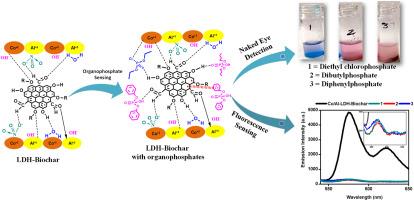Cobalt/Aluminum layered double hydroxide intercalated with rice straw based-biochar for recognizing organophosphates in cereal crops
IF 3.3
3区 物理与天体物理
Q2 OPTICS
引用次数: 0
Abstract
Herein, rice straw-based biochar was intercalated with Co/Al-LDH (LDH-Biochar) using a green technique based on the co-precipitation method. LDH-Biochar was further evaluated for the naked eye detection and spectrofluorimetric analysis of dibutyl phosphate (DBP), diphenyl phosphate (DPP), and diethyl chlorophosphate (DCP), which are extensively used as pesticides and flame retardants. The material inherited a fluorescent signal with a maximum at 570 nm (λexc = 520 nm) from the precursor ‘biochar’ and porous interactive surface from the precursor ‘LDH.’ It showed selective quenching for the organophosphates, i.e., DBP, DPP, and DCP, with a detection limit of 1.39 μM, 1.17 μM, and 1.29 μM, respectively, and the probe showed good response within the linear range of 1.9–25.3 μM. Furthermore, the method was successfully implemented to extract the organophosphates from wheat, corn, and pearl millet with recoveries in the range of 97.49–101.35 % (RSD; 0.27–3.22 %), 97.08–99.91 % (RSD; 0.27–3.17 %), and 98.18–103.54 % (RSD; 0.19–4.76 %), respectively. The outcome of this research is thus expected to help develop LDH-Biochar as a multi-analyte sensor for organophosphates (DBP, DPP, and DCP), which are extensively used as pesticides and flame retardants.

插层钴/铝双氢氧化物与稻草基生物炭用于识别谷类作物中的有机磷酸酯
本文采用基于共沉淀法的绿色技术,在稻草基生物炭中夹杂 Co/Al-LDH (LDH-生物炭)。研究人员进一步评估了 LDH-Biochar 对广泛用作农药和阻燃剂的磷酸二丁酯(DBP)、磷酸二苯酯(DPP)和氯磷酸二乙酯(DCP)的肉眼检测和光谱荧光分析能力。该材料继承了前体 "生物炭 "和多孔交互表面 "LDH "在 570 nm(λexc = 520 nm)处的最大荧光信号,对有机磷酸酯(即 DBP、DPP 和 DCP)表现出选择性淬灭,检测限分别为 1.39 μM、1.17 μM 和 1.29 μM,探针在 1.9-25.3 μM 的线性范围内表现出良好的响应。此外,该方法还成功地提取了小麦、玉米和珍珠粟中的有机磷,回收率分别为97.49-101.35 % (RSD; 0.27-3.22 %)、97.08-99.91 % (RSD; 0.27-3.17 %)和98.18-103.54 % (RSD; 0.19-4.76 %)。因此,该研究成果有望帮助开发出 LDH-生物炭,作为有机磷(DBP、DPP 和 DCP)的多分析物传感器,这些有机磷被广泛用作杀虫剂和阻燃剂。
本文章由计算机程序翻译,如有差异,请以英文原文为准。
求助全文
约1分钟内获得全文
求助全文
来源期刊

Journal of Luminescence
物理-光学
CiteScore
6.70
自引率
13.90%
发文量
850
审稿时长
3.8 months
期刊介绍:
The purpose of the Journal of Luminescence is to provide a means of communication between scientists in different disciplines who share a common interest in the electronic excited states of molecular, ionic and covalent systems, whether crystalline, amorphous, or liquid.
We invite original papers and reviews on such subjects as: exciton and polariton dynamics, dynamics of localized excited states, energy and charge transport in ordered and disordered systems, radiative and non-radiative recombination, relaxation processes, vibronic interactions in electronic excited states, photochemistry in condensed systems, excited state resonance, double resonance, spin dynamics, selective excitation spectroscopy, hole burning, coherent processes in excited states, (e.g. coherent optical transients, photon echoes, transient gratings), multiphoton processes, optical bistability, photochromism, and new techniques for the study of excited states. This list is not intended to be exhaustive. Papers in the traditional areas of optical spectroscopy (absorption, MCD, luminescence, Raman scattering) are welcome. Papers on applications (phosphors, scintillators, electro- and cathodo-luminescence, radiography, bioimaging, solar energy, energy conversion, etc.) are also welcome if they present results of scientific, rather than only technological interest. However, papers containing purely theoretical results, not related to phenomena in the excited states, as well as papers using luminescence spectroscopy to perform routine analytical chemistry or biochemistry procedures, are outside the scope of the journal. Some exceptions will be possible at the discretion of the editors.
 求助内容:
求助内容: 应助结果提醒方式:
应助结果提醒方式:


